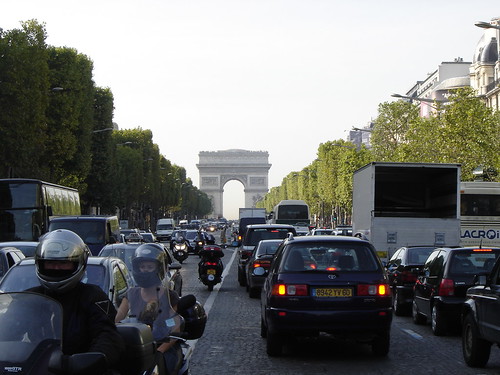根據歐盟官方資料,空氣汙染造成的健康支出和經濟損失每年耗費7億歐元。為解決空氣汙染問題,未來歐洲的城市將有機會依照空氣汙染的程度變換交通號誌。
建立空汙模型 提前2小時管制交通
要達成此目標,首先須建立完整的空氣汙染模型。由歐盟資助的MACC-II「空氣成分和氣候監控」研究計畫,可以提供精確的全歐空氣品質預測,預計將於今年稍晚上線運作。
以MACC-II數據和一般交通資訊為基礎,科學家開發出「iTRAQ動態交通管理系統」,利用道路交通網改善都市空氣品質,運作範圍為行政區域,或是主要的交通幹道。iTRAQ已通過可行性評估,將在2到3年內進行實地測試。
「iTRAQ能在2至3小時之前就提供交通控制策略,其中的關鍵就是MACC-II,因為它能提供小規模空氣汙染模型所需的資料,以及每小時的預報。」MACC-II合作夥伴,英國萊斯特大學天文物理系的研究員Roland Leigh說。
交通管制策略包括改變號誌燈號、加快或減慢變化頻率。「需要時,我們能藉由暫時抑制通風良好地區的交通,增加壅塞地區空氣流通,減少汙染的累積速度。」Leigh說。
MACC-II還能預測空氣中的氮氧化物和刺激性氣體等影響呼吸道物質的濃度,做為iTRAQ的基礎。未來還會納入其他有害汙染物,如地面臭氧和氣懸膠體。
專家:替代運輸工具仍應推廣
儘管解決空氣汙染問題乃當務之急,部分交通專家認為,這樣的系統有實作上的困難。
「模擬小範圍內的交通和空氣品質就已相當複雜,這也是iTRAQ的主要挑戰。」瑞士Jodar都市計畫顧問公司專家Gabriel Jodar說。Jodar公司提供西班牙巴塞隆納市政府空污交通管理方面的諮詢。
「在巴塞隆納,我們用的方式更簡單。我們依據空氣品質測量結果,將高速公路限速從每小時120公里逐漸減少至每小時60公里,並用雷達測量車速。」法國里昂市則是用道路工程設施和自行車道來減少交通運量。
「用空氣品質預測控制交通是個有趣的想法,但無益於提倡替代性運輸工具的使用。」負責都市生態和環境品質的里昂副市長Mireille Roy說,「空氣品質預測、交通管理系統和道路工程都只是輔助辦法,鼓勵使用替代性運輸工具才是最重要的目標。」
Phasing traffic lights according to air pollution rates at the scale of a European city district could soon become a reality. But first, the complexity of air pollution models must be mastered.
Poor air quality costs Europe more than €700 million a year in health expenditures and loss of economic performance, according to official EU sources.
To tackle this major issue, the EU-funded MACC-II [Monitoring atmospheric composition and climate] research project, due to be fully operational later this year, aims to deliver accurate air quality predictions across Europe.
Soon, these predictions could be used in traffic management. Scientists have developed iTRAQ, a dynamic traffic management system for optimizing use of the road network to achieve high standards of air quality in urban areas.
Its objective is to operate at the scale of a city district or even at the level of a main street. To achieve this goal, the system relies on both traffic information and on MACC-II data.
“iTRAQ will deliver traffic strategies two or three hours ahead,” says Roland Leigh, a researcher with the air quality group of the Department of Physics and Astronomy at England’s University of Leicester, a MACC-II partner.
“MACC-II is critical for this purpose, as it provides incoming data that we use to constrain our air pollution models at a smaller scale and for hourly forecasts,” he said.
Traffic control strategies consist in changing the phasing of traffic lights, speeding up or slowing down their frequency.
“If necessary, we can withhold the traffic in a well-vented area, whilst allowing free-flowing in a [congested] street, in order to reduce the accumulation of pollution,” Leigh said.
The iTRAQ feasibility study has been completed and field tests could be conducted within two or three years.
The system is based on predictions from MACC-II data on the atmospheric level of nitrogen oxides, irritant gases affecting the respiratory tract. Future solutions will include predictions of other harmful pollutants such as ground-level ozone and aerosols.
However desirable, such a system might be difficult to implement, some traffic analysts say.
“I see the complexity of modeling both traffic and air quality at small scales as the main obstacle for this project,” says Gabriel Jodar, of Jodar + partners, a Swiss consultancy specialized in urban planning.
His company advised the Spanish municipality of Barcelona on implementing traffic management solutions in response to high pollution rates.
“In Barcelona, we have chosen a simpler approach,” said Jodar. “As an example, we reduce speed on the motorway bypass from 120 km/h gradually down to 60 km/h depending on air quality measurements, and we check drivers’ speed with radars.”
By contrast, a city like Lyon, France has chosen to reduce traffic levels with roadwork amenities and cycle paths.
“Using air quality prediction to manage traffic is an interesting initiative,” says Mireille Roy, deputy mayor of Lyon, who is in charge of urban ecology and environmental quality. “But it doesn’t stimulate the search for alternative means of conveyance
Roy says, “Air quality predictions, traffic management systems and roadwork should be considered as complementary solutions.”
※ 全文及圖片詳見:ENS




